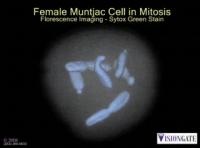Feb 9 2009
University of Washington researchers have helped develop a new kind of microscope to visualize cells in three dimensions, an advance that could bring great progress in the field of early cancer detection. The technique could also bridge a widening gap between cutting-edge imaging techniques used in research and clinical practices, researchers said.
 3-D microscope's image of a cell captured during cell division. Medical professionals could someday use such high-resolution movies to look for irregular chromosomes in human cells, as a possible indication of cancer. This cell belongs to a type of deer, a muntjac, and its six chromosomes have been colored with a fluorescent dye. The resolution of the image is 0.35 micrometers -- about three times better than that of the 2-D images currently used for cancer diagnoses. Credit: Michael Meyer, VisionGate
3-D microscope's image of a cell captured during cell division. Medical professionals could someday use such high-resolution movies to look for irregular chromosomes in human cells, as a possible indication of cancer. This cell belongs to a type of deer, a muntjac, and its six chromosomes have been colored with a fluorescent dye. The resolution of the image is 0.35 micrometers -- about three times better than that of the 2-D images currently used for cancer diagnoses. Credit: Michael Meyer, VisionGate
Eric Seibel, a UW mechanical engineering associate professor, and his colleagues have worked in collaboration with VisionGate, Inc., a privately held company in Gig Harbor, Wash., that holds the patents on the technology. The machine works by rotating the cell under the microscope lens and taking hundreds of pictures per rotation, and then digitally combining them to form a single 3-D image.
The 3-D visualizations could lead to big advances in early cancer detection, since clinicians today identify cancerous cells by using 2-D pictures to assess the cells' shape and size.
"It's a lot easier to spot a misshapen cell if you can see it from all sides," Seibel said. "A 2-D representation of a 3-D object is never perfectly accurate – imagine trying to get an exact picture of the moon, seeing only one side."
The new microscope, known by the trademarked name Cell-CT, is so named because it works similarly to a CT-scan – though on a very small scale, and using visible light instead of X-rays. In a CT-scan, the patient is immobile while the X-ray machine rotates. In the Cell-CT microscope, each cell is embedded in a special gel inside a glass tube that rotates in front of a fixed camera that takes many pictures per rotation. The gel has similar optical properties to the tube's so that no light reflects off the glass. In both processes, the end result is that hundreds of pictures are assembled to form a 3-D image that can be viewed and rotated on a computer screen.
The new 3-D microscope also helps to bring imaging techniques from the lab to the doctor's office. Although great advances have been made in microscope technology through the years, clinicians have been using essentially the same technique for cancer diagnoses for the last 300 years, Seibel said. Pathologists today still use a cell stain invented in the 1700s to examine sections of suspected cancers. Pathologists do not use any of the newer fluorescent molecular dyes that produce the precise, detailed cellular portraits found in biology journals.
"Scientists have been using fluorescent dyes in research for decades, but these techniques have not yet broken into everyday clinical diagnoses," Seibel said. "There's a big gap between the research and clinical worlds when it comes to cancer, and it's getting wider. We're trying to bridge that gap."
Part of the reason for this gap, Seibel said, is that there is no way to accurately match an image taken using the fluorescent dyes with an image taken using the traditional stains that currently form the basis for cancer diagnoses, and for which diagnostic standards exist. The new 3-D microscope will allow that matchup – Seibel and his colleagues have shown simultaneous fluorescent and traditional staining of the same cells. The new device is the first 3-D microscope that can use both traditional and fluorescent stains, Seibel said.
"Now that we have a way to compare these stains, we hope this will provide a way to get some of those sophisticated research techniques into clinical use," Seibel said.
The new microscope is also more precise than other 3-D machines currently available. All other microscopes producing 3-D images have poor resolution in the up-down direction, the direction between the sample and the microscope's lens, Seibel said.
Qin Miao, a UW bioengineering doctoral student, used a tiny plastic particle of known dimensions to show the microscope's resolution. He found that the UW group's machine has three times better accuracy in that up-down direction than standard microscopes used in cancer detection. Miao will present the group's findings for the microscope's performance Feb. 9 at the SPIE Medical Imaging conference in Orlando, Fla.
"This means we can do quantitative analysis of cells," Miao said. "This kind of undistorted image is difficult to achieve using other technology."
In another recent publication, Seibel and his colleagues describe a study comparing cancer detection using traditional methods with their 3-D microscope. Pathologists using 3-D technology detected cancer with one-third the error rate compared to those using the traditional microscope. The authors also describe using their microscope to discover a "pre-cancer" cell, a cell that was on the verge of turning cancerous.
"This is where we can make an impact in medicine – looking for these earliest changes," Seibel said.
Other authors of the paper are J. Richard Rahn, Ryland Bryant, Christy Lancaster, Anna Tourovskaia, Dr. Thomas Neumann and Alan Nelson, all of VisionGate.